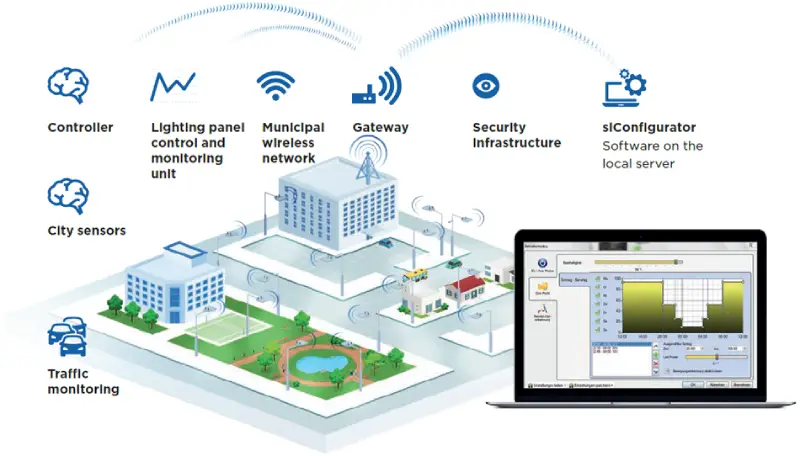With the development of technology, street lights have also entered the era of intelligence. Intelligent technology, mainly map positioning, can effectively manage public lighting and provide certain economic benefits. It is the technology that remotely manages and controls smart street lights. In addition to lighting, smart street lights can also provide functions such as video surveillance, emergency calls, wireless networks, and smart charging stations through smart street light poles. Let’s learn more about smart street lights below!
Introduction to Smart Street Lights
Wireless communication technology remotely controls and manages smart street lights. Remote management is the basic function of smart street lights. According to people’s needs, smart street lights can have other intelligent functions, including automatic brightness adjustment, proactive fault reminders, anti-theft and anti-destruction measures, and electricity consumption records. Smart street lights improve lighting efficiency, reduce ineffective lighting and light pollution, and reduce energy waste and maintenance costs.
These lights bring some wireless communication equipment, and the communication function of these devices can effectively promotes social intelligence development. Smart lighting is only the most basic function of smart street lights. With the development of technology, people will use the communication equipment on smart street lights to achieve other functions.
The Way Smart Street Light Control System Work

The smart street light control system is divided into hardware and software systems. The hardware system is responsible for data information collection and communication, while the software system is responsible for data processing and display. The cooperation of the hardware and software systems can realize the functions of monitoring the working status of street lights, recording electricity usage, circuit control, fault prompts, and observation and control by mobile devices. Many functions of smart street lights can be expanded according to actual needs, such as vehicle flow detection and light sensing detection.
The smart street light control system can easily locate the position of the street lights through GPS function, and then flexibly schedule the street lights according to actual needs, reducing the brightness and number of lights in areas with less vehicle and pedestrian traffic.
Smart Street Lamp Control System

Hardware System
The hardware design of smart lighting system mainly includes node controllers, GPRS modules, sensor modules, and power modules. In the node controller, it is common to use GPRS communication and Zigbee technology to form data transmission, collect information from sensors and LED street Light, and transmit data to the monitoring center (street lamp monitoring cloud platform). When using the GPRS module, remote data connection can be achieved using the network of mobile operators. The main function of the sensor module is to monitor the illuminance and operating status. TSL2550, which is a digital signal acquisition chip, can be used for the intensity of illumination. Combined with two photodiodes and a data compression converter in the circuit, it can provide real-time data on light intensity over a wide dynamic range.
Software System
In the design of the intelligent control system for city street lamp illumination, after the main system is completed, detailed calculations and correct handling of the network formed by the network sensors in each module must be carried out. The next step is to correspondingly pair the illumination sensors and operation sensors. The routing node sensor is processed and transmitted to the coordinator via Zigbee technology, and then transmitted to the host computer via GPRS. The host computer processes the relevant data information to ensure that all programs work smoothly, thereby achieving normal illumination control and monitoring. In the entire design process of the lighting system, it is also necessary for the lamps to complete superior commands and implement final states. For lamps that do not operate normally, technicians will receive alarms and then perform inspection and maintenance to achieve real-time monitoring.
Advantages of Smart Street Lights
Intelligent Control
The lighting mode has been further improved and can be intelligently controlled. Intelligent street lamps adjust the brightness of the lights according to the traffic flow and actual lighting requirements on the road. This makes the brightness of the lamps more humanized, meets the needs of different scenarios, and saves a lot of electricity. Some can even realize the control of color temperatures.
Long Service Life
The cost-effectiveness of intelligent street lamps is far higher than that of traditional street lamps. Traditional street lamps may be damaged under full load pressure for a long time, resulting in scrapping. However, intelligent street lamps can greatly reduce full load hours due to intelligent control, thereby increasing the service life of traditional street lamps by 20%. It is one thing you need to consider when choosing LED lights.
Convenient Maintenance
Maintenance of traditional street lamps requires manpower and vehicles for inspection and repair, but the intelligent street lamps will help reduce later human and material charges in the total costs. For example, the intelligent street lamps with their remote monitoring performance, can be checked its operating status of street lamps without visiting the site.
Disadvantages of Smart Street Lights

Partly weakening of lighting function
Smart streetlights should focus on lighting as the main function and then add other functions on top of that. However, in reality, this is not always the case. Many projects use integrated designs for the lamp arm and fixture for aesthetic reasons. Instead of using standardized products from lighting companies, the construction unit purchases LED modules and driving power supplies and assembles them on-site according to the shape of the lamp post. Due to a lack of testing and certification for the entire lamp, lighting distribution and electrical safety cannot be guaranteed. The quality and effectiveness are unsatisfactory, which also does not facilitate subsequent maintenance management. The lighting function is severely weakened, which is actually not conducive to the promotion and application of smart streetlights.
Inadequate electrical design considerations
Smart streetlights have many functions, and strong and weak electricity coexist. But the internal space of the lamp post is limited, which requires high requirements for electrical design and wiring methods. From current projects, there are mixed wiring of strong and weak electricity, chaotic wiring at the lamp door. Some projects even connect wires in lighting handholes to reduce the diameter of the lamp post, which poses serious safety hazards in rainy days. Even in projects with relatively standardized wiring, there are environmental conditions that are not suitable. Smart streetlights generally connect wires at the base lamp door, which is highly humid and hot, and the protection level is insufficient. Whether using terminal blocks or connectors, they are prone to failure, even rusting and heating over time, which increases the risk factor of 24-hour-powered smart streetlights.
Incomplete power supply and communication support
Smart streetlights are equipped with intelligent lighting, video collection, and mobile communication as standard. Intelligent lighting and communication electricity are easy to solve, while video collection and mobile communication require laying fiber optic cables, and the requirements for power supply reliability are also high. If information release screens and charging piles are also equipped, the electricity load is more than what the current cables can bear. Currently, some projects have heavy pole bodies but unreasonable cable and fiber optic support. Some projects are fully prepared in advance, but there is no plan for when to put them into use, leading to excessive sunk costs. Some projects did not even reserve pipelines, and excavation of pipelines in the later stage will increase operating costs. Against the backdrop of accelerated construction of 5G sites, the problem of disordered construction of smart streetlights is becoming more and more severe.
Insufficient expandability of lamp posts
Smart streetlights are the fulcrum of current applications, and they should also reserve sufficient interfaces for future demand. Technology is rapidly evolving, and demand is constantly changing. It is neither possible nor realistic to think through all the functions of smart streetlights now. Many projects are based on 4G technology to imagine the application scenarios of 5G or even 6G. The lifespan of a lamp post can reach 20 years, and openness and expandability are essential requirements for smart streetlights. Currently, the industry has a tendency to equate smartness with the number of functions, but it lacks consideration. It will be troublesome to replace or add new functions in the future. Besides, if the width of the road changes, setting a new height of the pole is also hard to realize.
Functions of Smart Street Lamp Poles

Smart street lamp poles are a new type of intelligent device based on lighting poles. They integrate various perception sensors such as audio and video monitoring equipment, wireless base stations, WIFI hotspots, multimedia screens, charging piles, and weather and environmental sensors. The functions of smart street lamp poles mainly include:
Intelligent lighting
Smart street lamps can adjust the brightness automatically according to the light intensity without steps. Besides, they can automatically report faults and realize intelligent single-lamp/centralized control without manual operation.
Video surveillance
Smart lamp poles have functions such as face recognition and license plate recognition. They can connect to the criminal system and automatically report alarms and actively warn.
RFID
It has RFID function and can realize functions such as special population monitoring, manhole cover monitoring, community, and municipal security monitoring.
Emergency call
It can install IP one-button for help, video for help, IP broadcasting, public broadcasting, etc. This help to realize the contact between the field extension and the monitoring center for the active broadcasting function.
Sensor access
Smart street lights can connect various types of sensors. For example, noise sensors, air pollution sensors, temperature/humidity sensors, and brightness sensors. Such connection helps monitor real-time environmental temperature, humidity, PM2.5, wind direction, wind speed, noise, water accumulation and other data.
Wireless network
The pole has WIFI hotspot and can complete the construction of urban WIFI, and can also be an important equipment for 5G micro-base station construction.
Information release and interaction
Those adopt high-brightness outdoor LED screens can remotely control the playback of advertising content. through mobile phones/computers, you can choose to play them in split screens or timed playback.
Intelligent charging pile
It can complete the charging function of electric cars and electric bicycles. Through the app, users can search for the location of the pile and reserve it. It also has leakage, over-current, overload protection, lightning protection, etc.
Development of Smart Street Lamp Technology

The smart street lamp system is an old engineering problem that applies new technology. Modern smart street lamp systems have extensively applied advanced energy-saving algorithms, energy-saving materials, and communication technology, achieving initial energy-saving, communication digitalization, and control and maintenance automation.
However, the development of human society’s modern industry and the Internet+ era has brought problems. Urban development, people’s travel needs, and energy shortages have put forward further requirements for the development and enhancement of smart street lamp systems. In addition to the development of system artificial intelligence, remote networking, and management integration, in critical energy-saving control technology and communication technology, it is necessary to conduct more in-depth exploration and research on the existing basis.
Research on more efficient and intelligent energy-saving algorithms
Most of the current energy-saving strategies use fuzzy control for the brightness control of street lamps. In the future, high-dimensional fuzzy algorithms or artificial intelligence algorithms such as neural networks that are also suitable for nonlinear time-varying systems are likely to improve system accuracy.
Application research of new communication technology
The currently widely used ZigBee close-range transmission and GPRS long-distance transmission methods are reasonable. However, new-generation long-distance transmission technologies, such as the fourth-generation mobile telecommunication standard (4G), are already mature. Its transmission rate is much larger than that of GPRS technology, and it can provide better transmission quality. Therefore, it is entirely possible to consider using 4G technology for long-distance data transmission. The integration of the entire street lamp lighting system and the Internet to form an IoT street lamp lighting system is also feasible.
Engineering experimental verification research on intelligent energy-saving control, communication, and other technologies
Currently, there is more theoretical research and relatively less experimental research. In the future, it is essential to have more experimental testing to verify the feasibility of various technologies.
The future of Intelligent Street Lights

In modern society, as the level of urbanization continues to increase, the city’s street lighting system is also constantly expanding and improving. The street lighting system is no longer just a facility that provides road lighting and convenience for travel. It has become an important part of urban infrastructure, occupying a pivotal position in the city’s traffic safety, social security, and people’s livelihood. It beautifies urban landscape, and bears the task of enhancing the city’s image. How a city’s lighting system is built marks the strength and maturity of the city.
In the design process of the street lighting system, in addition to the basic lighting function design, comprehensive design considerations such as energy efficiency, intelligent operation, and convenient maintenance are important. Therefore, the street lighting system is a multi-system integration product that comprehensively applies technologies from multiple fields such as light source materials, energy-saving control, communication links, sensing detection, and the Internet of Things. The scope involved is relatively broad. Among them, the research and results of energy-saving control and communication technology in recent years have played a pivotal role. They solve the problems of efficient energy-saving and intelligent management of street lighting systems. In this way, intelligent street lamp systems practical systems can continue to develop and innovate.
Due to technological limitations, the development of intelligent street lamps has been relatively slow. But the market demand for smart street lamps is relatively large. Further development in communication and other fields of technology will promote the development of intelligent street lamps. In the future, intelligent street lamps will gradually replace traditional street lamps. Mokolight street lights keep evolving to apply the newest technology. Our certified and customized street lights satisfy our customers and light up their projects.




